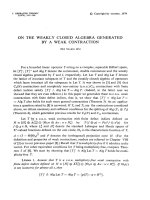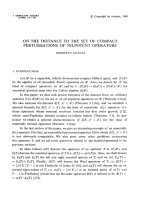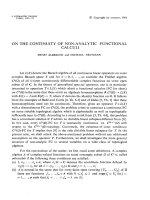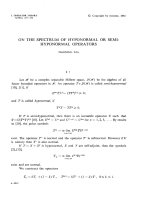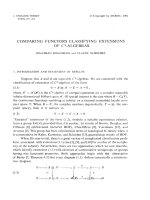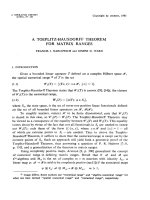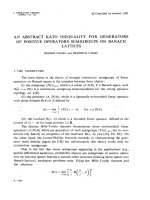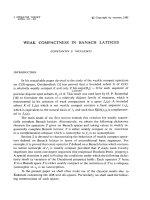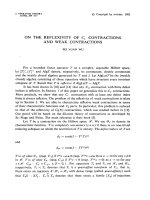Báo cáo toán học: "On the Asymptotic Distribution of the Bootstrap Estimate with Random Resample Size" ppsx
Bạn đang xem bản rút gọn của tài liệu. Xem và tải ngay bản đầy đủ của tài liệu tại đây (139.71 KB, 10 trang )
Vietnam Journal of Mathematics 33:3 (2005) 261–270
On the Asymptotic Distribution of the
Bootstrap Estimate with Random Resample Size
*
Nguyen Van Toan
Department of Mathematics, College of Science,
Hue University, 77 Nguyen Hue, Hue, Vietnam
Received Demcember 19, 2003
Abstract In this paper, we study the bootstrap with random resample size which is
not independent of the original sample. We find sufficient conditions on the random
resample size for the central limit theorem to hold for the bootstrap sample mean.
1. Introducti on
Efron [5] discusses a “bootstrap” method for setting confidence intervals and
estimating significance levels. This method consists of approximating the dis-
tribution of a function of the observations and the underlying distribution, such
as a pivot, by what Efron calls the bootstrap distribution of this quantity. This
distribution is obtained by replacing the unknown distribution by the empirical
distribution of the data in the definition of the statistical function, and then
resampling the data to obtain a Monte Carlo distribution for the resulting ran-
dom variable. Efron gives a series of examples in which this principle works, and
establishes the validity of the approach for a general class of statistics when the
sample space is finite.
The first necessary condition for the bootstrap of the mean for independent
identically distributed (i.i.d.) sequences and resampling size equal to the sample
size was given in [8] showing that the bootstrap works a.s. if and only if the
common distribution of the sequence has finite second moment, while it works
∗
This research is supported i n part by the National Fundamental Research Program in Natural
Science Vietnam, No. 130701.
262 Nguyen Van Toa n
in probability if and only if that distribution belongs to the domain of attraction
of the normal law. Hall [10] completes the analysis in this setup showing that
when there exists a bootstrap limit law (in probability) then either the parent
distribution belongs to the domain of attraction of the normal law or it has
slowly varying tails and one of the two tails completely dominates the other.
The interest of considering resampling sizes different to the sample size was
noted among others by Bickel and Freedman [3], Swanepoel [19] and Athreya
[1].
In sufficiently regular cases, the bootstrap approximation to an unknown
distribution function has been established as an improvement over the simpler
normal approximation (see [2, 6- 7]). In the case where the bootstrap sample
size N is in itself a random variable, Mammen [11] has considered bootstrap with
a Poisson random sample size which is independent of the sample. Stemming
from Efron’s observation that the information content of a bootstrap sample
is based on approximately (1 − e
−1
)100% ≈ 63% of the original sample, Rao,
Pathak and Koltchinskii [17] have introduced a sequential resampling method
in which sampling is carried out one-by-one (with replacement) until (m +1)
distinct original observation appear, where m denotes the largest integer not
exceeding (1−e
−1
)n. It has been shown that the empirical characteristics of this
sequential bootstrap are within a distance O(n
−3/4
) from the usual bootstrap.
The authors provide a heuristic argument in favor of their sampling scheme and
establish the consistency of the sequential bootstrap. Our work on this problem
is limited to [12 - 16] and [20 - 21]. In these references we consider bootstrap
with a random resample size which is independent of the original sample and find
sufficient conditions for random resample size that random sample size bootstrap
distribution can be used to approximate the sampling distribution. The purpose
of this paper is to study bootstrap with a random resample size which is not
independent of the original sample.
2. Results
Let S
n
=(X
1
,X
2
, , X
n
) be a random sample from a distribution F and
θ(F ) a parameter of interest. Let F
n
denote the empirical distribution function
based on S
n
and suppose that θ(F
n
) is an estimator of θ(F ). The Efron boot-
strap method approximates the sampling distribution of a standardized version
of
√
n(θ(F
n
) − θ(F )) by the resampling distribution of a corresponding statis-
tic
√
n(θ(F
∗
n
) − θ(F
n
)) based on a bootstrap sample S
∗
n
. Here the original F
has been replaced by the empirical distribution based on the original sample
S
n
and F
n
of the former statistic has been replaced by the empirical distribu-
tion based on a bootstrap sample F
∗
n
. In Efron’s bootstrap resampling scheme,
S
∗
n
=(X
∗
n1
,X
∗
n2
, , X
∗
nn
) is a random sample of size n drawn from S
n
by
simple random sampling with replacement. In Rao, Pathak and Koltchinskii
[17] sequential scheme, observations are drawn from S
n
sequentially by simple
random sampling with replacement until there are m +1 = [n(1 − e
−1
)] + 2
distinct original observations in the bootstrap sample; the last observation is
discarded to ensure technical simplicity. Thus an observed bootstrap sample
Asymptotic Distribution of the Bootstrap Estimate with Random Resample Size 263
under the Rao-Pathak-Koltchinskii scheme admits the form
S
∗
N
n
=(X
∗
n1
,X
∗
n2
, , X
∗
nN
n
)
where X
∗
n1
,X
∗
n2
, , X
∗
nN
n
have m ≈ n(1 −e
−1
)distinctobservationsfromS
n
.
The random sample size N
n
admits the following decomposition in terms of the
independent random variables:
N
n
= N
n1
+ N
n2
+ + N
nm
where m =[n(1 − e
−1
)] + 1; N
1
= 1 and for each k, 2 ≤ k ≤ m,
P
∗
(N
nk
= i)=
1 −
k −1
n
k −1
n
i−1
,
where P
∗
denotes conditional probability P ( |X
1
, ,X
n
).
Rao, Pathak and Koltchinskii [17] have established the consistency of this
sampling scheme. In this paper we investigate the random bootstrap sample size
N
n
such that the following condition is satisfied:
(1) Along almost all sample sequences X
1
,X
2
, ,given S
n
=(X
1
,X
2
, ,
X
n
), as n tends to infinity, the sequence
N
n
k
n
1≤n<∞
converges in conditional
probability to a positive random variable ν, where (k
n
)
1≤n<∞
is an increasing
sequence of positive integer number tending to infinity when n tends to infinity:
that is, for ε>0,
P
∗
N
n
k
n
− ν
>ε
→ 0a.s.
We state now our main result.
Theorem 2.1. Let X
1
,X
2
, be a sequence of i.i.d random variables on a
probability space (Ω, A,P) with mean μ and finite positive variance σ
2
. Let F
n
be
the empirical distribution of S
n
=(X
1
, ,X
n
). Given S
n
=(X
1
, ,X
n
), let
X
∗
n1
, ,X
∗
nm
, be conditionally independent random variables with common
distribution F
n
and (N
n
)
n≥1
be a sequence of positive integer valued random
variables such that condition (1) holds. Denote
¯
X
n
=
1
n
n
i=1
X
i
,
¯
X
∗
N
n
=
1
N
n
N
n
i=1
X
∗
ni
,s
∗2
N
n
=
1
N
n
N
n
i=1
(X
∗
ni
−
¯
X
∗
N
n
)
2
.
Along almost all sample sequences, as n tends to infinity:
sup
−∞<x<+∞
P
√
n(
¯
X
n
− μ) <x
− P
∗
N
n
(
¯
X
∗
N
n
−
¯
X
n
) <x
→ 0.
3. Proofs
For the proof of Theorem 2.1 we will need the following results.
Lemma 3.1. (Guiasu, [9]) Let
264 Nguyen Van Toa n
(W
n
)
1≤n<∞
, (x
mn
)
1≤n<∞
1≤m<∞
, (y
mn
)
1≤n<∞
1≤m<∞
be sequences of random variables such that for every m and n we have
W
n
= x
mn
+ y
mn
.
Let us supp ose that the following conditions are satisfied:
(A) The distribution functions of the sequence (x
mn
)
1≤n<∞
converge to the dis-
tribution function F for each fixed m;
(B) ∀ε>0 : lim
m→∞
lim sup
n
P (|y
mn
| >ε)=0
then distribution functions of sequence (W
n
)
1≤n<∞
converge also to F.
Lemma 3.2. [4, Lemma 3] Let (η
n
)
1≤n<∞
be a sequence of independent ran-
dom variables, further let (k
n
)
1≤n<∞
and (m
n
)
1≤n<∞
,k
n
≤ m
n
, be two (not
constant) sequenc e s of natural numbers. If for each n, A
n
is an even t depend-
ing only on t he random variables η
k
n
, , η
m
n
then for every event A, having
positive probability:
lim sup
n
P (A
n
|A) = lim sup
n
P (A
n
).
The proof of Theorem 2.1 is somewhat long, so we shall separate out the
major steps and present them in the form of lemmas.
Denote
s
2
n
=
1
n
n
i=1
(X
i
−
¯
X
n
)
2
,
¯
X
∗
nm
=
1
m
m
i=1
X
∗
ni
,
s
∗2
m
=
1
m
m
i=1
(X
∗
ni
−
¯
X
∗
nm
)
2
and Y
∗
nm
=
√
m
s
n
¯
X
∗
nm
−
¯
X
n
.
Lemma 3.3. For every event A, having positive proba bility, we have
lim
m→∞
n→∞
P
∗
A
(Y
∗
nm
≤ x)=Φ(x) a.s.,
where P
∗
A
( ) is conditional probability P
∗
( |A) and Φ(x) is the standard
normal distribution function.
Proof. For every event A, P
∗
(A) > 0, we have
lim
m→∞
n→∞
P
∗
A
(Y
∗
nm
≤ x)=Φ(x) ⇔ lim
m→∞
n→∞
E
∗
(e
itY
∗
nm
|A)=e
−
t
2
2
, ∀t,
where E
∗
( ) is the conditional expectation E( |X
n1
, ,X
nn
).
Therefore, the lemma follows if we show that for all t
lim
m→∞
n→∞
E
∗
(e
itY
∗
nm
|A)=e
−
t
2
2
a.s.
Asymptotic Distribution of the Bootstrap Estimate with Random Resample Size 265
For every natural number n denote by F
n
the tail σ-field of the sequence
(X
∗
nm
)
1≤m<∞
and let F be the σ-field generated by
∞
n=1
F
n
.
Since F
n
is trivial on the probability space (Ω, A,P
∗
) for every n (n =
1, 2, ), F is also trivial on the probability space (Ω, A,P
∗
).
Consider, for fixed t, the sequence ξ
∗
nm
= e
itY
∗
nm
of bounded random variables
on the probability space (Ω, A,P
∗
) which is necessarily uniformly integrable.
It is well known that a sequence of random variables is relatively sequentially
L
1
(Ω, A,P
∗
)-weakly compact if and only if it is uniformly integrable.
Hence, there exists a subsequence random variables of ξ
nm
that converges
weakly in L
1
(Ω, A,P
∗
) to some random variable α(t). It is easy to check that
α(t)isF-measurable. But F is trivial, and so α(t)mustbeaconstant(P
∗
-a.s.).
By Theorem 2.1 of Bickel and Freedman [3], the conditional distribution
function of Y
∗
mn
converges almost surely to the standard normal distribution
function as n and m tend to ∞. Hence α(t)hastobee
−
t
2
2
and
lim
m→∞
n→∞
E
∗
(e
itY
∗
nm
|A)=e
−
t
2
2
a.s.
Thus all subsequences of ξ
nm
which converge weakly in L
1
(Ω, A,P
∗
), converge
to e
−
t
2
2
a.s. and so the original sequence must converge weakly in L
1
(Ω, A,P
∗
)
to e
−
t
2
2
a.s. also. This holds for all real t, the lemma is proved.
Lemma 3.4. For every ε>0 and η>0 there exists a positive real number
s
0
= s
0
(ε, η) and a natural number m
0
= m
0
(ε, η) such that for every m>m
0
,
we have
P
∗
max
i:|i−m|<s
0
m
|Y
∗
ni
− Y
∗
nm
| >ε
<η
for every natural number n.
Proof. It is easy to check that
P
∗
max
i:|i−m|<s
0
m
|Y
∗
ni
− Y
∗
nm
| >ε
≤ P
∗
max
i:|i−m|<s
0
m
|Y
∗
ni
− Y
∗
n[(1−s
0
)m]
| >
ε
2
+ P
∗
|Y
∗
nm
− Y
∗
n[(1−s
0
)m]
| >
ε
2
,
where [x] is the largest integer ≤ x.
Applying the well-known inequalities of Tchebychev and Kolmogorov one
obtains the following inequalities:
P
∗
max
i:|i−m|<s
0
m
|Y
∗
ni
− Y
∗
n[(1−s
0
)m]
| >
ε
2
≤
16
ε
2
u
v
+
v
u
− 2
u
v
P
∗
|Y
∗
nm
− Y
∗
n[(1−s
0
)m]
| >
ε
2
≤
32
ε
2
1 −
u
m
,
where u =[(1−s
0
)m],v=[(1+s
0
)m].
266 Nguyen Van Toa n
From the above inequalities we obtain the result desired.
Lemma 3.5. For every ε>0 and η>0 there exists a positive real number
s
0
= s
0
(ε, η) and a natural number m
0
= m
0
(ε, η) such that for every m>m
0
we have
P
∗
A
max
i:|i−m|<s
0
m
|Y
∗
ni
− Y
∗
nm
| >ε
<η
for every natural number n and every A ∈A, (P
∗
(A) > 0).
Proof. By Lemma 3.4, for every ε>0andη>0 there exists a positive real
number s
0
= s
0
(ε, η) such that
lim sup
m
P
∗
max
i:|i−m|<s
0
m
|Y
∗
ni
− Y
∗
nm
| >ε
<η
for every natural number n.
We notice also that for every ε>0andη>0 the event
max
i:|i−m|<s
0
m
|Y
∗
ni
− Y
∗
nm
| >ε
∈K
[(1−s
0
)m]+1
,
where K
[(1−s
0
)m]+1
is the σ-algebra generated by the sequence of random vari-
ables (Y
nk
)
[(1−s
0
)m]+1≤k<∞
.
Therefore
lim sup
m
P
∗
A
max
i:|i−m|<s
0
m
|Y
∗
ni
− Y
∗
nm
| >ε
= lim sup
m
P
∗
max
i:|i−m|<s
0
m
|Y
∗
ni
− Y
∗
nm
| >ε
<η
for every natural number n and every A ∈A, (P
∗
(A) > 0), by Lemma 3.2.
Thus, for every ε>0andη>0 there exists a positive real number s
0
=
s
0
(ε, η) and a natural number m
0
= m
0
(ε, η) such that for every m>m
0
,we
have
P
∗
A
max
i:|i−m|<s
0
m
|Y
∗
ni
− Y
∗
nm
| >ε
<η
for every natural number n and every A ∈A, (P
∗
(A) > 0), which completes the
proof.
Proof of Theorem 2.1.
If EX
2
< ∞ then s
2
n
→ σ
2
a.s. Therefore, the theorem follows if we show that
the conditional distribution of Y
∗
nN
n
converges weakly to N(0, 1) a.s.
Let (ν
m
)
1≤m<∞
be the usual sequence of elementary random variables which
approximates the random variable ν on the probability space (Ω, A,P
∗
). For
every natural number m and h define
A
hm
= {(h − 1)2
−m
<ν≤ h2
−m
} = {ν
m
= h2
−m
}.
Obviously
Asymptotic Distribution of the Bootstrap Estimate with Random Resample Size 267
A
hm
A
km
= ∅,h= k,
∞
h=1
A
hm
=Ω,m=1, 2,
Since for every m (m =1, 2, )
∞
h=1
P
∗
(A
hm
)=1
then, for every η>0 and every m there exists a natural number l
∗
= l
∗
(m, η)
such that
∞
h=l
∗
+1
P
∗
(A
hm
) <η,
or equivalently:
l
∗
h=1
P
∗
(A
hm
) ≤ 1 − η.
We shall denote the set of events {A
1m
,A
2m
, , A
l
∗
m
} by ε(l
∗
(m, η)) and
the sequence (ε(l
∗
(m, η)))
1≤m<∞
by ε
ν
(η).
According to the notation of Lemma 3.1, we put
x
∗
mn
= Y
∗
n[k
n
ν
m
]
,y
∗
mn
= Y
∗
nN
n
− Y
∗
n[k
n
ν
m
]
,W
∗
n
= Y
∗
nN
n
.
Obviously,
W
∗
n
= x
∗
mn
+ y
∗
mn
for any n, m (n, m =1, 2, ).
Let us show that all conditions of Lemma 3.1 are satisfied. Indeed,
([k
n
h2
−m
])
1≤n<∞
is a sequence of natural number, for every m and h (m, h =
1, 2, ). Lemma 3.3 implies that for every η>0,A
hm
∈ ε
ν
(η) and every real
number x there exits a natural number n
0
= n
0
(η, x, h, m) such that for every
n>n
0
we have
P
∗
A
hm
Y
∗
n[k
n
h2
−m
]
≤ x
− Φ(x)
<ηa.s.
We put now
n
∗
= n
∗
(η, x, m)= max
1≤k≤l
∗
n
0
(η, x, h, m)(l
∗
= l
∗
(m, η))
and for simplicity of notation, we let
Δ
1
mn
=
∞
h=1
P
∗
Y
∗
n[k
n
ν
m
]
≤ x
A
hm
− Φ(x)
,
Δ
11
mn
=
l
∗
h=1
P
∗
Y
∗
n[k
n
ν
m
]
≤ x
A
hm
− Φ(x)
l
∗
h=1
P
∗
A
hm
,
268 Nguyen Van Toa n
Δ
12
mn
=
∞
h=l
∗
+1
P
∗
Y
∗
n[k
n
ν
m
]
≤ x
A
hm
,
Δ
13
mn
=Φ(x)
∞
h=l
∗
+1
P
∗
A
hm
,
then for every m (m =1, 2, )ifn>n
∗
we have
P
∗
(x
∗
mn
≤ x) − Φ(x)
=
P
∗
Y
∗
n[k
n
ν
m
]
≤ x
− Φ(x)
=Δ
1
mn
≤ Δ
11
mn
+Δ
12
mn
+Δ
13
mn
≤
l
∗
h=1
P
∗
A
hm
Y
∗
n[k
n
h2
−m
]
≤ x
− Φ(x)
P
∗
(A
hm
)+2
∞
h=l
∗
+1
P
∗
(A
hm
)
<η
l
∗
h=1
P
∗
(A
hm
)+2η<3η a.s.
i.e.
lim
n→∞
P
∗
(x
mn
≤ x)=Φ(x)a.s.
for any m (m =1, 2, ).
Therefore condition (A) of Lemma 3.1 is satisfied a.s.
Now, for all ε>0, consider the following events:
B
mn
=
Y
∗
nN
n
− Y
∗
n[k
n
ν
m
]
>ε
,
C
mn
=
N
n
k
n
− ν
< 2
−m
,
D
mn
=
N
n
k
n
− ν
≥ 2
−m
,
E
mn
=
∞
h=1
max
i:
i
N
n
−ν
<2
−m
Y
∗
ni
− Y
∗
n[k
n
h2
−m
]
>ε
A
hm
,
F
mn
=
∞
h=1
max
i:(h−2)2
−m
k
n
<i<(h+1)2
−m
k
n
Y
∗
ni
− Y
∗
n[k
n
h2
−m
]
>ε
A
hm
.
From condition (1) we have
lim
m→∞
lim sup
n
P
∗
(|y
∗
mn
| >ε) = lim
m→∞
lim sup
n
P
∗
B
mn
≤ lim
m→∞
lim sup
n
P
∗
B
mn
∩C
mn
+ lim
m→∞
lim sup
n
P
∗
D
mn
= lim
m→∞
lim sup
n
P
∗
∞
h=1
B
mn
∩ C
mn
∩A
hm
≤ lim
m→∞
lim sup
n
P
∗
E
mn
≤ lim
m→∞
lim sup
n
P
∗
F
mn
a.s., (1)
where in the last inequality we have taken into account that the inequality
i
k
n
− ν
< 2
−m
Asymptotic Distribution of the Bootstrap Estimate with Random Resample Size 269
implies
(h − 2)2
−m
k
n
<i<(h +1)2
−m
k
n
, (2)
because on the set A
hm
we have (h − 1)2
−m
<ν<h2
−m
.
From Lemma 3.5 it follows that for every ε>0andη>0thereexistsa
positive real number s
0
= s
0
(ε, η) such that
lim sup
j
P
∗
A
hm
max
i:|i−j|<s
0
j
|Y
∗
ni
− Y
∗
nj
| >ε
<η (3)
for every natural number n and every A
hm
∈ ε
ν
(η).
Let us choose the natural number m
0
= m
0
(ε, η) such that m
0
s
0
> 2and
such that for m>m
0
P
∗
(ν<m2
−m
) <η a.s. (4)
Some simple calculations show that for every m>m
0
and h ≥ m if n is
sufficiently large, the inequality (2) implies
|i − [k
n
h2
−m
]| <s
0
[k
n
h2
−m
]. (5)
Now, using (3) and (4) it follows that for m>m
0
we have
lim
m→∞
lim sup
n
P
∗
F
mn
≤ Δ
∗
+ P
∗
(ν<m2
−m
)+
∞
h=l
∗
+1
P
∗
(A
hm
)
<η
l
∗
h=m
P
∗
(A
hm
)+η + η<3η a.s., (6)
where
Δ
∗
=
l
∗
h=m
lim sup
n
P
∗
A
hm
max
i:|i−[k
n
h2
−m
]|<s
0
[k
n
h2
−m
]
Y
∗
ni
−Y
∗
n[k
n
h2
−m
]
>ε
P
∗
(A
hm
).
Thusfrom(1)and(6)itresults
lim
m→∞
lim sup
n
P
∗
(|y
∗
mn
| >ε)=0a.s., ∀ε>0.
Therefore the condition (B) of Lemma 3.1 is satisfied too and we have
lim
n→∞
P
∗
Y
∗
nN
n
≤ x
= lim
n→∞
P
∗
W
∗
n
≤ x) = lim
n→∞
P
∗
(x
∗
mn
≤ x
=Φ(x) a.s.,
which proves the theorem.
References
1. K. B. Athreya, Bootstrap of the Mean in the infinite variance Case, Proceedings of
the 1st World Congress of the Bernoulli Society, Y. Prohorov and V. V. Sazonov
(Eds.) VNU Science Press, The Netherlands, 2 (1987) 95–98.
270 Nguyen Van Toa n
2. R. Beran, Bootstrap method in statistics, Jahsesbe r. Deutsch. M ath. -Verein 86
(1984) 14–30.
3. P. J. Bickel and D. A. Freedman, Some asymptotic theory for the bootstrap, Ann.
Statist. 9 (1981) 1196–1217.
4. J. Blum, D. Hanson, and J. Rosenblatt, On the central limit theorem for the sum
of a random number of independent random variables, J. Z. Wahrscheinlichkeit-
stheorie verw. Gebiete 1 (1963) 389–393.
5. B. Efron, Bootstrap methods: Another look at the Jackknife, Ann. Statist. 7
(1979) 1–26.
6. B. Efron, Nonparametric standard errors and confidence intervals (with discus-
sion), Canad. J. Statist. 9 (1981) 139–172.
7. B. Efron and R. Tibshirani, Bootstrap methods for standard errors, confidence
intervals, and other measures of statistical accuracy (with discussion), Statist.
Sci. 1 (1986) 54–77.
8. E. Gin´e and J. Zinn, Necessary conditions for the bootstrap of the mean, Ann.
Statist. 17 (1989) 684–691.
9. S. Guiasu, On the asymptotic distribution of the sequences of random variables
with random indices, J. Ann. Math. Statist. 42 (1971) 2018–2028.
10. P. Hall, Asymptoyic Properties of the Bootstrap of Heavy Tailed Distribution,
Ann. Stati s t. 18 (1990) 1342–1360.
11. E. Mammen, Bootstrap, wild bootstrap, and asymptotic normality, Prob. Theory
Relat. Fields 93 (1992) 439–455
12. Nguyen Van Toan, Wild bootstrap and asymptotic normality, Bulletin, College
of Science, Hue University, 10 (1996) 48–52.
13. Nguyen Van Toan, On the bootstrap estimate with random sample size, Scientific
Bulletin of Universities (1998) 31–34.
14. Nguyen Van Toan, On the asymptotic accuracy of the bootstrap with random
sample size, Vietnam J. Math. 26 (1998) 351–356.
15. Nguyen Van Toan, On the asymptotic accuracy of the bootstrap with random
sample size, Pakistan J. Statist. 14 (1998) 193–203.
16. Nguyen Van Toan, Rate of convergence in bootstrap approximations with random
sample size, Acta Math. Vietnam. 25 (2000) 161–179.
17. C. R. Rao, P. K. Pathak, and V. I. Koltchinskii, Bootstrap by sequential resam-
pling, J. Statist. Plann. I nference 64 (1997) 257–281.
18. A. Renyi, On the central limit theorem for the sum of a random number of
independent random variables, Acta Math. Acad. Sci. Hungar. 11 (1960) 97–
102.
19. J. W. H. Swanepoel, A note in proving that the (Modified) Bootstrap works,
Commun. Statist. Theory Meth. 15 (1986) 3193–3203.
20. Tran Manh Tuan and Nguyen Van Toan, On the asymptotic theory for the boot-
strap with random sample size, Proceedings of the National Centre for Science
and Technology of Vietnam 10 (1998) 3–8.
21. Tran Manh Tuan and Nguyen Van Toan, An asymptotic normality theorem of
the bootstrap sample with random sample size, VNU J. Science Nat. Sci. 14
(1998) 1–7.
